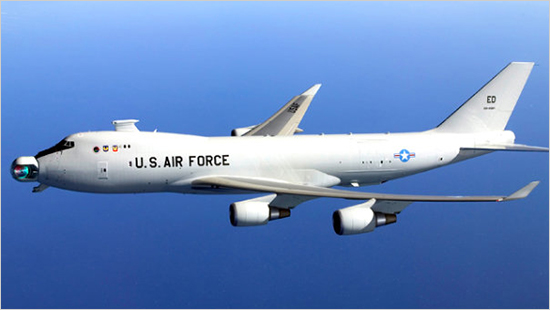
FOX News 26 Ottobre 2010
Boeing: il raggio della morte non funziona. E’ fallita la sperimentazione del laser aerotrasportato che (secondo il costruttore Boeing) avrebbe dovuto abbattere missili nemici in un lampo, nelle guerre del futuro. La guerra del futuro è rimandata, il lasero-cilecca produce un buco nel grasso contratto Boeing, e il Pentagono dovrà rinunciare al suo ultimo costosissimo gadget ad alta tecnologia per vincere guerre virtuali. Purtroppo le forze Usa dovranno ancora contrastare i talebani sull’aspro terreno della realtà. Del resto, i talebani non hanno missili da abbattere. La loro guerera è primitiva, ma stanno vincendo. Chissà perchè.A converted Boeing 747 equipped with a powerful laser failed to shoot down a mock enemy ballistic missile, the Pentagon's Missile Defense Agency said on Thursday, the system's second botched flight test in a row.
Preliminary indications are that the so-called Airborne Laser Test Bed tracked the target's exhaust plume but did not hand off to a second, "active tracking" system as a prelude to firing the high-powered chemical laser, said Richard Lehner, an MDA spokesman.
"The transition didn't happen," he said. "Therefore, the high-energy lasing did not occur."
Boeing produces the airframe and is the project's prime contractor, while Northrop Grumman supplies the high-energy laser and Lockheed Martin has been developing the beam- and fire-control systems.
Defense Secretary Robert Gates scaled back the program into a research experiment last year.
About $4 billion has gone into it since the Boeing-led team won the contract for it in 1996. The system is designed to focus a super-heated, basketball-sized beam on a pressurized part of a boosting missile long enough to cause it to fail.
For fiscal 2011 that began Oct. 1, President Barack Obama asked Congress for $98.6 million for all of the Defense Department's directed energy research, including the Airborne Laser Test Bed.
Previously, the flying raygun had been under development as a potential part of a layered U.S. ballistic missile shield against weapons that could be fired by countries such as Iran and North Korea. Pentagon planners initially envisaged using the aircraft to shoot down ballistic missiles near their launch pads.
"The reality is that you would need a laser something like 20 to 30 times more powerful than the chemical laser in the plane right now to be able to get any (safe) distance from the launch site to fire," Gates told the House of Representatives Appropriations Defense subcommittee last year after scaling it back.
The technology is now being tested for other potential missile-defense applications.
The United States has been spending about $10 billion a year to build a bulwark against missiles that could be tipped with chemical, biological or nuclear warheads.
The MDA said in a statement on its website that officials would investigate the cause of the Airborne Laser system's "transition failure" in the test that took place late Wednesday off the Southern California coast.
"The intermittent performance of a valve within the laser system is being examined," the statement said. A spokeswoman for Boeing's directed energy program, Elizabeth Merida, referred calls to the MDA.
The Airborne Laser system successfully shot down a target ballistic missile in February in the first such test of a flying directed-energy weapon.
The initial success demonstrated the potential use of directed energy against enemy ballistic missiles shortly after they are launched, Pentagon and Boeing officials have said.
The system's second shoot-down test, also at the Point Mugu military test range off California, failed on Sept. 1.
That test was designed to double the distance between the 747-400F aircraft and the target to about 100 miles. But it ended early when corrupted beam control software steered the high-energy laser slightly off center, apparently because of a communications software error, the MDA said.
Lehner said the range of the latest test was "the same as the successful February experiment" -- that is about 50 miles, although the exact range remains classified.
The MDA still considers directed energy "in some form," possibly a solid-state laser, to have a lot of potential for missile defense, he said.
The system carried a price tag of $1 billion to $1.5 billion per aircraft before Gates canceled a possible second aircraft in June 2009.
Source > FOX News